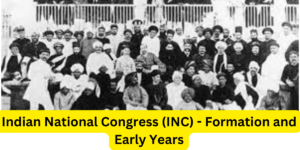Hyder Ali
Early Period of Hyder Ali:
- Fath Muhammad, who was a general in the army of the Carnatic Nawab, gave birth to Hyder Ali between 1717 and 1722. His actual ancestry is unknown, though he said he belonged to the Bani Hashim clan of Qureshi. His mother’s name is unclear.Hyder began his military career along with the Wodeyar rajas of Mysore. Before becoming a Nayak, he was first posted as a jagir in Pudikot village.
- After his father was killed in battle, Hyder and his brother Shahbaz served the Arcot kings for many years. They eventually went to Seringapatam, where Hyder’s uncle was in charge.
- They were drafted into the Mysore Army, and Haider first served under Shahbaz.
- Haider’s leadership skills were soon recognized, and he commanded 100 cavalry and 2,000 soldiers under Shahbaz. He finally became Nanjaraj’s most trusted subordinate.
- Despite several obstacles, including a conspiracy by some nobles and Marathas, Hyder Ali managed to establish his authority north of the Tungabhadra River by
- Hyder Ali continued to fight with the Marathas in the northwest and the British on the east and west coasts. He used diplomacy and a large army to hold or expand his territory.
Hyder Ali’s Promotion:
- Mysore was a small state within the Vijayanagara Empire. After the fall of Vijayanagara in 1565, the Wodeyars declared independence and in 1578 Raja Wodeyar became the kingdom.
- Haider’s father Fateh Muhammad served as Faujdar of Kolar. Hyder rose in the military ranks, reaching a notable position in
- He crushed the rebellions and recovered the Mysore territories from the Marathas, earning the title “Fateh Hyder Bahadur”.
- Hyder cooperated with the French against the British, but he faced internal threats, which he managed efficiently and eventually became the de facto ruler in 1770.
- After the Diwani attained distinction, the British avoided interfering in the internal affairs of the Indian countries and tried to protect their territory. Hyder Ali and the Nizam of Hyderabad threatened the British in the Carnatic region.
- Hyder ruled as a secular king who upheld religious freedom and Hindu legal
- He revolutionized the government by building roads, gardens and forts in Bengaluru and Seringapattam.
- His son Tipu Sultan continued similar changes, which helped the re-established Wadiyar monarchy under British administration.
- Hyder Ali led troops and cavalry, profiting from his victories. In 1755, he was known as Dindigul Faujdar.
- He hired French artillery specialists and fought French generals throughout the Carnatic Wars.
- He accepted control of the Nizami army and defeated the Marathas and seized lands. He suffered a setback and paid for peace, but eventually invaded and recovered lost territories.
Mysore War
- Following the Carnatic Wars , the British East India Company established authority in the important southern cities.
- The Kingdom of Mysore, controlled by the Wadiyar dynasty, faced threats under the Madras Presidency of the neighbouring countries such as the Marathas, Travancore, Hyderabad , and the British.
- Hyder Ali played an important role in securing Mysore’s borders and strengthening its army.
Hyder Ali’s Promotion:
- Starting in 1755, Hyder Ali supervised conflicts against the Mysore neighbours and successfully controlled threats.
- He served alongside the French in the Carnatic War, gained combat experience and strengthened the Mysore army.
- In 1759, King Krishnaraja Wodeyar II conferred the title of Fath Haider Bahadur on Hyder Ali. Hyder Ali used the tensions and the empty Mysore treasury to come to power in court, eventually becoming king after ousting the prime minister in 1761.
- He firmly established himself as Sultan Hyder Ali Khan and expanded his kingdom in South India through strategic tactics.
First Anglo-Mysore War (1767–1799):
- The British controlled trading centres such as Pondicherry and Arcot, but Hyder Ali aimed to expand into a less powerful Madras Presidency.
- The Nizam of Hyderabad launched the war to divert the British attention from the northern governments.
- In 1767, Hyder Ali declared war on the East India Company, first joining the Nizam of Hyderabad. Hyder Ali was able to pay the Marathas, prompting them to withdraw their help, and the Nizam of Hyderabad eventually turned to the side.
- In the Battle of Trinamalai, the British soldiers left Mysore and Hyderabad behind , the Nizam of Hyderabad concluded a treaty with the British and Mysore fought alone.
- Caught between the three armies, Hyder Ali chose peace, which resulted in the Treaty of Madras signed in 1769 between Mysore and the British.
Second Anglo-Mysore War (1780 – 1784 CE):
- Hyder Ali went to war with the Marathas in 1770 and expected British support under the Treaty of Madras, but the British refused.
- Hyder Ali, feeling deceived, joined the French following the Anglo-French War of
- Conflict broke out again in the Indian subcontinent, and the British tried to oust the French.
- Hyder Ali strategically assessed Mahe, a French-controlled port, and formed a confederacy with the Nizam of Hyderabad and the Marathas against the British.
- In 1780, Hyder Ali occupied the Carnatic coast with a large army, culminating in the defeat of the British at the Battle of Pollilur.
- Sir Iyer Coote finally defeated Hyder Ali in the Battle of Parangipettai in 1781. Hyder Ali died in 1782, and his son Tipu Sultan followed his aggressive policies.
- Tipu Sultan resisted the British, conquered Mangalore, and prohibited the shipment of certain goods to Europe .
- The French navy withdrew support, and the Treaty of Mangalore in 1784 ended the conflict with the restoration of the borders.
Third Anglo-Mysore War (1790 – 1792 CE):
- Tipu Sultan modernized his army with French help and attacked the neighbouring kingdom of Travancore.
- Lord Charles Cornwallis led the British and their allies in the war against Mysore.
- The conflict lasted for three years and ended with the surrender of Tipu Sultan during the Siege of Srirangapatna .
- The strict terms of the Seringapatam Agreement included territorial concessions, regular ‘security’ money for EIC, the release of prisoners of war, and the holding of two sons hostage.
Fourth Anglo-Mysore War (1798 – 1799 CE):
- The new Governor-General Richard Wellesley tried to end the French-Mysore alliance, hoping that Tipu Sultan would regain control of his territory with French help.
- In 1799, the British, with the support of the Maratha confederacy and the Nizam of Hyderabad, laid siege to Srirangapatna.
- Tipu Sultan was killed in action, and signed a treaty with Mysore EIC, establishing British sovereignty and establishing a puppet king.
- This was the beginning of sub-alliances in India, the Nizam of Hyderabad was the first to sign.
- In 1799, a puppet king belonging to the Wadiyar dynasty was established to limit the border of Mysore and bring it under British control. The British officially conquered Mysore in 1831, although the Wodeyars continued to rule as puppets.
- The Wodeyars ruled the remainder of the Kingdom of Mysore until 1947, when it joined the domination of India.
Conclusion Hyder Ali:
Hyder Ali’s legacy was always identified with anti-imperialism and was an inspiration to those who later led the Indian freedom struggle. He restored, however, order and efficiency to a zone he left unchanged for his son. The old order disintegrates. He lived in India during a transition period when neocolonial rule was still in the making. Tipu Sultan is considered a rebel hero, but he is known for managing his kingdom as efficiently and efficiently as his father. Tipu took Mysore to the pinnacle of military might.




karmyn gryffroy
Pingback: Early Rebellions Against The British